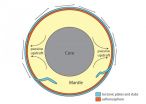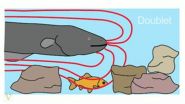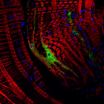(Press-News.org) An international team, including scientists from DESY, has caught a light sensitive biomolecule at work with an X-ray laser. The study proves that X-ray lasers can capture the fast dynamics of biomolecules in ultra slow-motion, as the scientists led by Prof. Marius Schmidt from the University of Wisconsin-Milwaukee write in the journal Science. "Our study paves the way for movies from the nano world with atomic spatial resolution and ultrafast temporal resolution", says Schmidt.
The researchers used the photoactive yellow protein (PYP) as a model system. PYP is a receptor for blue light that is part of the photosynthetic machinery in certain bacteria. When it catches a blue photon, it cycles through various intermediate structures as it harvests the energy of the photon, before it returns to its initial state. Most steps of this PYP photocycle have been well studied, making it an excellent candidate for validating a new method.
For their ultra-fast snapshots of the PYP dynamics, the scientists first produced tiny crystals of PYP molecules, most measuring less than 0.01 millimetres across. These microcrystals were sprayed into the focus of the world's most powerful X-ray laser, LCLS at the SLAC National Accelerator Laboratory in the US, as their photocycle was kicked off with a meticulously synchronised blue laser pulse. Thanks to the incredibly short and intense X-ray flashes of the LCLS, the researchers could watch how PYP changes its shape at different time steps in the photocycle, by taking snapshot X-ray diffraction patterns.
With a resolution of 0.16 nanometres, these are the most detailed images of a biomolecule ever made with an X-ray laser. A nanometre is a millionth of a millimetre. The diameter of the smallest atom, hydrogen, is about 0.1 nanometres.
Beyond reproducing known aspects of the PYP photocycle, thereby validating the new method, this investigation revealed much finer details. Also, thanks to the high temporal resolution, the X-ray laser could, in principle, study steps in the cycle that are shorter than 1 picosecond (a picosecond is a trillionth of a second) - too fast to be caught with previous techniques. The ultrafast snapshots can be assembled into a movie, showing the dynamics in ultra slow-motion.
"This is a real breakthrough", emphasises co-author Prof. Henry Chapman from the Center for Free-Electron Laser Science at DESY, who is also a member of the Hamburg Centre for Ultrafast Imaging. "Our study is opening the door for time resolved studies of dynamic processes with atomic resolution."
Compared to other methods, X-ray lasers, like the LCLS or the European XFEL that is currently being built from the DESY campus in Hamburg to the neighbouring town of Schenefeld, offer several advantages for the investigation of ultrafast dynamics of molecules. They produce the most brilliant X-ray flashes on earth, offering femtosecond time resolution. A femtosecond is a quadrillionth of a second. While 40 femtosecond X-ray flashes were used for this experiment, the pulse duration can be made even shorter down to just a few femtoseconds.
"You need a short pulse to resolve the steps of these fast processes", underlines co-author Dr. Anton Barty, also from DESY. "The short flashes also overcome the problem of damaging the often delicate samples with the intense X-rays." Although the powerful pulses usually vaporise the sample, they are so short that they produce a high-quality diffraction signal on the detector before the sample disintegrates. This principle, called diffraction before destruction, was proven a few years ago by an international collaboration led by DESY.
X-ray lasers use a fresh sample for every shot, which also avoids radiation damage that can accumulate in the samples in other types of investigations. And X-ray lasers typically investigate very small crystals that often are much easier to fabricate than larger crystals. In fact, some biomolecules are so hard to crystallise that they can only be investigated with an X-ray laser. The small crystal size is also an advantage when it comes to kick-starting molecular dynamics uniformly across the sample. In larger samples, the initiating optical laser pulse is often quickly absorbed in the sample, which excites only a thin layer and leaves the bulk of the crystal unaffected. The PYP microcrystal dimensions were perfectly matched to the optical absorption so that all molecules in the crystal were undergoing the same dynamics, which in turn allowed sensitive measurements of the molecular changes by snapshot X-ray diffraction.
Taken together, X-ray laser investigations can offer previously inaccessible new insights into the dynamics of the molecular world, complementing other methods. Using the ultra slow-motion, the scientists next plan to elucidate the fast steps of the PYP photocycle that are too short to be seen with previous methods.
INFORMATION:
The team included researchers from the University of Wisconsin-Milwaukee, Arizona State University, SLAC National Accelerator Center, Lawrence Livermore National Laboratory, DESY, University of New York Buffalo, University of Chicago and Imperial College London.
Reference
"Time-resolved serial crystallography captures high-resolution intermediates of photoactive yellow protein", Jason Tenboer et al., Science (2014), DOI: 10.1126/science.1259357
Deutsches Elektronen-Synchrotron DESY is the leading German accelerator centre and one of the leading in the world. DESY is a member of the Helmholtz Association and receives its funding from the German Federal Ministry of Education and Research (BMBF) (90 per cent) and the German federal states of Hamburg and Brandenburg (10 per cent). At its locations in Hamburg and Zeuthen near Berlin, DESY develops, builds and operates large particle accelerators, and uses them to investigate the structure of matter. DESY's combination of photon science and particle physics is unique in Europe.
The temperature of the seawater around Antarctica is rising according to new research from the University of East Anglia.
New research published today in the journal Science shows how shallow shelf seas of West Antarctica have warmed over the last 50 years.
The international research team say that this has accelerated the melting and sliding of glaciers in the area, and that there is no indication that this trend will reverse.
It also reveals that other Antarctic areas, which have not yet started to melt, could experience melting for the first time with consequences ...
CORVALLIS, Ore. - Scientists may have solved a long-standing enigma known as the African Humid Period - an intense increase in cumulative rainfall in parts of Africa that began after a long dry spell following the end of the last ice age and lasting nearly 10,000 years.
In a new study published this week in Science, an international research team linked the increase in rainfall in two regions of Africa thousands of years ago to an increase in greenhouse gas concentrations. The study was funded by the National Science Foundation and the U.S. Department of Energy.
The ...
A long-held assumption about the Earth is discussed in today's edition of Science, as Don L. Anderson, an emeritus professor with the Seismological Laboratory of the California Institute of Technology, and Scott King, a professor of geophysics in the College of Science at Virginia Tech, look at how a layer beneath the Earth's crust may be responsible for volcanic eruptions.
The discovery challenges conventional thought that volcanoes are caused when plates that make up the planet's crust shift and release heat.
Instead of coming from deep within the interior of the ...
VIDEO:
Vanderbilt biologist Kenneth Catania describes his discovery that the electroshock system used by the electric eel to detect and immobilize prey is uncannily similar to the Taser.
Click here for more information.
The electric eel - the scaleless Amazonian fish that can deliver an electrical jolt strong enough to knock down a full-grown horse - possesses an electroshock system uncannily similar to a Taser.
That is the conclusion of a nine-month study of the way in which ...
The "survival of the fittest" principle applies to cells in a tissue - rapidly growing and dividing cells are the fit ones. A relatively less fit cell, even if healthy and viable, will be eliminated by its more fit neighbors. Importantly, this selection mechanism is only activated when cells with varying levels of fitness are present in the same tissue. If a tissue only consists of less fit cells, then no so-called cell competition occurs. Molecular biologists from the University of Zurich and Columbia University are the first researchers to demonstrate in a study published ...
Since 2010, detections of Asian Carp environmental DNA or "eDNA" have warned scientists, policymakers, and the public that these high-flying invaders are knocking on the Great Lakes' door. Scientists capture tiny DNA-containing bits from water and use genetic analysis to determine if any Asian Carp DNA is present. New research published by Notre Dame scientists shows that the tools currently used for Asian Carp eDNA monitoring often fail to detect the fish. By comparison, the new eDNA methods described in this study capture and detect Asian Carp eDNA more effectively.
The ...
ITHACA, N.Y. - Among the billions and billions of stars in the sky, where should astronomers look for infant Earths where life might develop? New research from Cornell University's Institute for Pale Blue Dots shows where - and when - infant Earths are most likely to be found. The paper by research associate Ramses M. Ramirez and director Lisa Kaltenegger, "The Habitable Zones of Pre-Main-Sequence Stars" will be published in the Jan. 1, 2015, issue of Astrophysical Journal Letters.
Images and study: https://cornell.box.com/infantearths
"The search for new, habitable ...
For nearly 40 years, one of the cornerstones of the study of adaptation has been the examination of "whole-organism performance capacities"--essentially, measures of the dynamic things animals do: how fast they can run; how hard they can bite; how far, fast, and high they can jump; and so on. Together, these functional attributes determine the performance of a species' ecology: the types of food one can eat; the ability to capture or locate prey; the ability to avoid predation; the ability of males to intimidate or, in some cases, prevent rival males from invading a territory; ...
Insects can transmit viral diseases to humans. Therefore, understanding how insects cope with viral infection, and what immune mechanisms are triggered, can be important to stop diseases transmission. In a study published in this week's issue of the scientific journal PLOS Pathogens*, researchers from the Instituto Gulbenkian de Ciencia (IGC; Portugal) now show that the entry route of the virus changes how the insect host responds to it. Using the fruit flies as a model of study, they discovered an immune mechanism that is specifically effective when flies are infected ...
BOULDER - New research demonstrates for the first time that an increase in greenhouse gas concentrations thousands of years ago was a key factor in causing substantially more rainfall in two major regions of Africa. The finding provides new evidence that the current increase in greenhouse gases will have an important impact on Africa's future climate.
The study, led by the National Center for Atmospheric Research (NCAR), is being published this week in Science.
"The future impact of greenhouse gases on rainfall in Africa is a critical socioeconomic issue," said NCAR ...


